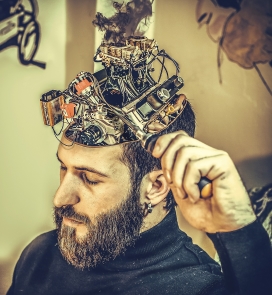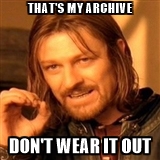
When we hear of augmentation in digital terms, these days we more often than not think of augmented or mixed reality, where digital information, imagery etc. is overlain on our view of the real world around us. This is, as yet, a relatively specialised field in archaeology (e.g. see Eve 2012). But digital augmentation of archaeology goes far beyond this. Our archaeological memory is augmented by digital cameras and data archives; our archaeological recording is augmented by everything from digital measuring devices through to camera drones and laser scanners; our archaeological illustration is augmented by a host of tools including CAD, GIS, and – potentially – neural networks to support drawing (e.g. Ha and Eck 2017); our archaeological authorship is augmented by a battery of writing aids, if not (yet) to the extent that data structure reports and their like are written automatically for us (for example).

 I’ve commented
I’ve commented  We often hear of the active archive, but what about an idle one? In a post on
We often hear of the active archive, but what about an idle one? In a post on  We’re accustomed to the fact that much archaeology is collaborative in nature: we work with and rely on the work of others all the time to achieve our archaeological ends. However, what we overlook is the way in which much of what we do as archaeologists is dependent upon invisible collaborators – people who are absent, distanced, even disinterested. And these aren’t archaeologists working remotely and accessing the same virtual research environment as us in real time, although some of them may be archaeologists who developed the specialist software we have chosen to use. The majority of these are people we will never know, cannot know, who themselves will be ignorant of the context in which we have chosen to apply their products, and indeed, to compound things, will generally be unaware of each other. They are, quite literally, the ghosts in the machine.
We’re accustomed to the fact that much archaeology is collaborative in nature: we work with and rely on the work of others all the time to achieve our archaeological ends. However, what we overlook is the way in which much of what we do as archaeologists is dependent upon invisible collaborators – people who are absent, distanced, even disinterested. And these aren’t archaeologists working remotely and accessing the same virtual research environment as us in real time, although some of them may be archaeologists who developed the specialist software we have chosen to use. The majority of these are people we will never know, cannot know, who themselves will be ignorant of the context in which we have chosen to apply their products, and indeed, to compound things, will generally be unaware of each other. They are, quite literally, the ghosts in the machine. Visualisation is much in vogue at present, especially with the increasing availability and accessibility of virtual reality devices such as the
Visualisation is much in vogue at present, especially with the increasing availability and accessibility of virtual reality devices such as the